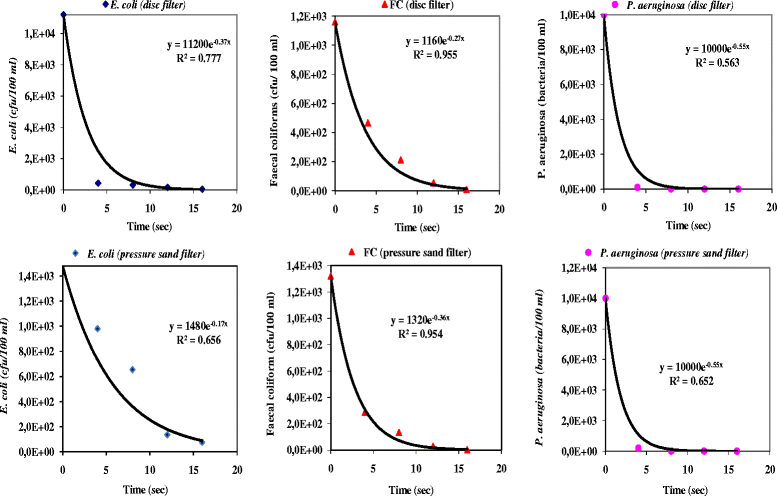Bacteriological quality of effluent submitted consecutively to a macrofiltration and ultraviolet light systems in the Tunisian conditions
- PMID: 25729583
- PMCID: PMC4345008
- DOI: 10.1186/s40201-015-0154-6
Bacteriological quality of effluent submitted consecutively to a macrofiltration and ultraviolet light systems in the Tunisian conditions
Abstract
This paper deals with the study of bacteriological quality of effluents that have undergone consecutively different macrofiltration system (pressure sand filter or disc filter used as a secondary treatment) and UV254 irradiation process (used as a tertiary treatment). These two successive systems of treatment were evaluated to determine their possible application as commonly alternatives to the conventional system of wastewater treatment and disinfection before wastewater reuse. They both combined systems of wastewater treatment released effluent of excellent bacteriological quality, with almost total absence of feacal coliforms, of E. coli and of P. aeruginosa). However, if the bacteriological quality of the effluent remained constant in the case of macrofiltration system (disc filter or pressure sand filter); the UV disinfection process showed to deeply depend on the quality of effluent, particularly with regard to UV transmittance. The daily bacteriological monitoring of the secondary effluent at the exit of the pressure sand filter by UV reactor and by using a dose of 96 mJ/cm(2), corresponding to an exposure of 16 min, showed an average rate of inactivation of around 3 U-Log, for feacal coliforms, E. coli and P. aeruginosa, respectively. Therefore, the average bacterial concentration remaining in the water at the exit of the UV reactor is less than 1000 cfu/100 ml for feacal coliform and E. coli. For P. aeruginosa, the remaining number is less than 100 bacteria/100 ml. These two last values coincide substantially with the range recommended by several standardized international guidelines. Therefore, numerous authors reported that P. aeruginosa is very resistant to UV irradiation compared to the other bacterial indicators. In contrast, our study revealed that feacal coliforms and E. coli were more UV light resistant than P. aeruginosa. This finding could be explained by the fact that E. coli and feacal coliform forms aggregates in the treated effluent, while P. aeruginosa exists either as discrete cells or as cell pairs.
Keywords: Disinfection; Macrofiltration systems; Reuse; UV reactor; Wastewater.
Figures






Similar articles
-
Experimental study on the disinfection efficiencies of a continuous-flow ultrasound/ultraviolet baffled reactor.Ultrason Sonochem. 2015 Nov;27:81-86. doi: 10.1016/j.ultsonch.2015.05.002. Epub 2015 May 9. Ultrason Sonochem. 2015. PMID: 26186823
-
[Inactivation of bacteria and coliphages in surface water highly polluted by secondary effluent and purified by flocculation and filtration by means of UV irradiation at a pilot plant scale].Zentralbl Hyg Umweltmed. 1993 Sep;194(5-6):490-507. Zentralbl Hyg Umweltmed. 1993. PMID: 8267835 German.
-
Feasibility study of UV disinfection for agricultural reuse of secondary level effluent in Korea.J Environ Sci Health A Tox Hazard Subst Environ Eng. 2004;39(3):835-46. doi: 10.1081/ese-120027745. J Environ Sci Health A Tox Hazard Subst Environ Eng. 2004. PMID: 15055945
-
Upflow anaerobic sludge blanket reactor--a review.Indian J Environ Health. 2001 Apr;43(2):1-82. Indian J Environ Health. 2001. PMID: 12397675 Review.
-
Inactivation credit of UV radiation for viruses, bacteria and protozoan (oo)cysts in water: a review.Water Res. 2006 Jan;40(1):3-22. doi: 10.1016/j.watres.2005.10.030. Water Res. 2006. PMID: 16386286 Review.
Cited by
-
Modeling and kinetic characterization of wastewater disinfection using chlorine and UV irradiation.Environ Sci Pollut Res Int. 2016 Oct;23(19):19861-75. doi: 10.1007/s11356-016-7173-4. Epub 2016 Jul 16. Environ Sci Pollut Res Int. 2016. PMID: 27421857
-
The response of aggregated Pseudomonas putida CP1 cells to UV-C and UV-A/B disinfection.World J Microbiol Biotechnol. 2016 Nov;32(11):185. doi: 10.1007/s11274-016-2138-9. Epub 2016 Sep 21. World J Microbiol Biotechnol. 2016. PMID: 27655528
References
-
- Gómez A, Plaza F, Garralón G, Pérez J, Gómez MA. A comparative study of tertiary wastewater treatment by physico-chemical-UV process and macrofiltration-ultrafiltration technologies. Desal. 2007;202:369–76. doi: 10.1016/j.desal.2005.12.076. - DOI
-
- Deepali, Namita J. Problems of ground water contamination with focus on waterborne diseases, causes and prevention. App Sci Report. 2014;1(1):34–41.
-
- Lazarova V, Savoye P, Janex MI, Blatchley ER, III, Pommepuy M. Advanced wastewater disinfection technologies: state of the art and perspectives. Wat Sci Tech. 1999;40:203–13. doi: 10.1016/S0273-1223(99)00502-8. - DOI
-
- Chun-Chieh T, Chih-Shan L. Inactivation of virus-containing aerosols by ultraviolet germicidal irradiation. Aerosol Sci Technol. 2005;39(12):1136–42. doi: 10.1080/02786820500428575. - DOI
-
- Naddeo V, Cesaro A, Mantzavinos D, Fatta-Kassinos D, Belgiorno V. Water and wastewater disinfection by ultrasound irradiation -a critical review. Global Nest J. 2014;16(3):561–77.
LinkOut - more resources
Full Text Sources
Other Literature Sources

